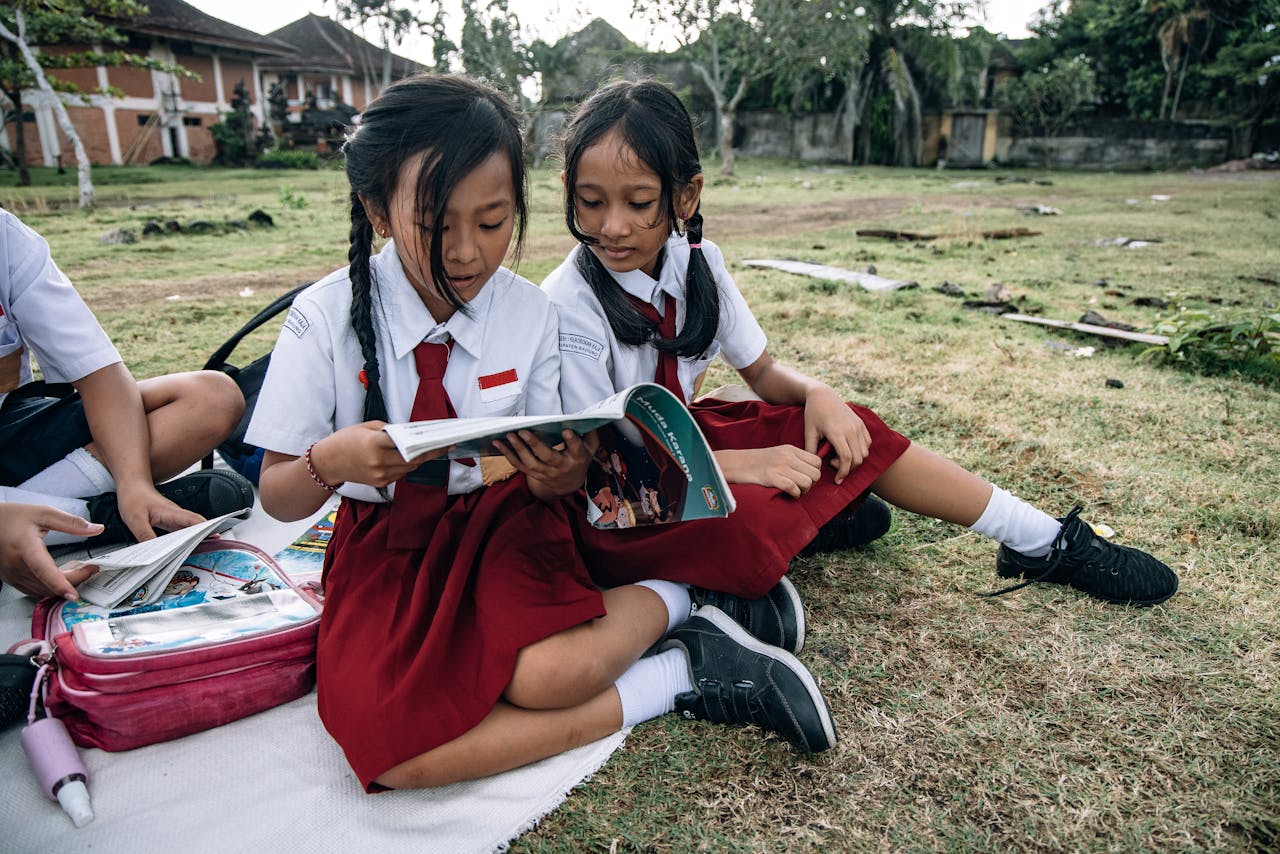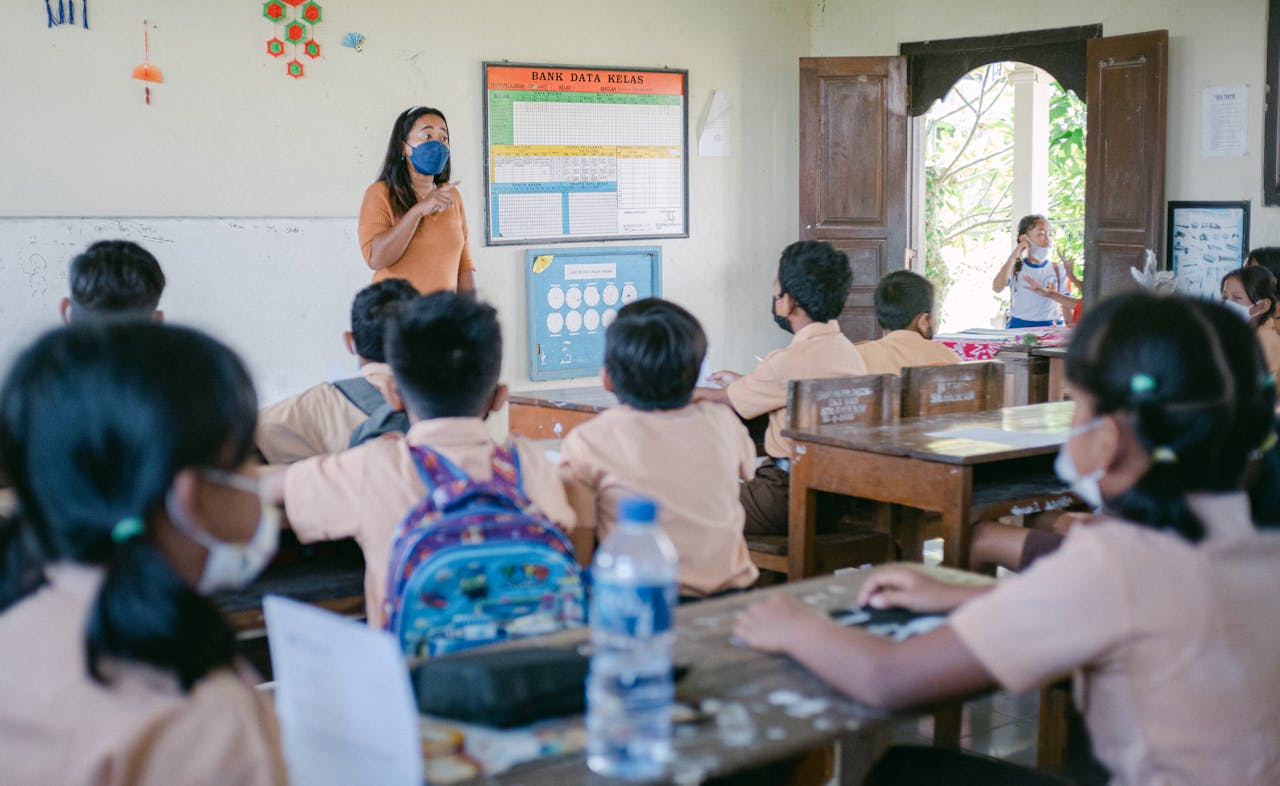350 Heartfelt Words from a Mother to Her Child
Here is a collection of 350 heartfelt words from a mother to her child.

Kapanlagi.com - Pronouns are an important part of sentence construction in Indonesian. The correct use of pronouns can make sentences more effective and pleasant to read. Here is a complete explanation regarding pronouns:

school students (credit: pexels.com)
1. Pronouns are words used to replace nouns or people in a sentence
2. They function to avoid the repetition of the same word continuously
3. They make sentences more effective and concise
4. They can replace subjects, objects, or predicates in a sentence
5. Their positions can change according to the context of the sentence
6. Replaces the name or title of a person
7. Divided into first, second, and third person pronouns
8. Examples: I, me, you, he, they
9. Used to point to an object, place, or thing
10. Consists of general, place, and thing indicators
11. Examples: this, that, there, here, like this, like that
12. Functions as question words to request information
13. Inquires about people, objects, places, time, or conditions
14. Examples: what, who, where, when, why, how
15. Indicates ownership or possession
16. Usually added after nouns
17. Examples: -my, -your, -his/her
18. Connects two sentences or two things
19. Usually uses the word “that”
20. Example: The book that I read is very interesting
21. Refers to things with unclear information
22. Indicates an uncertain quantity
23. Examples: someone, something, each, people
24.I will go to the market tomorrow morning
25.You need to study harder
26.They are playing in the park
27.We will hold a meeting today
28.He/She did not go to school because of illness
29.Please take this book
30. The house is very big and luxurious
31.Put the items there
32.This is how to solve math problems
33.Don't do that to your friend
34.Who knocked on the door earlier?
35.What are you working on?
36.Where did you put the car keys?
37. When will we go on vacation?
38.Why do you look sad today?
39.My book was left at school
Their house is at the end of the street
Your car is very nice and luxurious
Their bag was left on the bus
Our cat is white and black
44. The girl wearing the red dress is my sister
45.The book I read was very interesting
46.The person who helped that grandmother is very kind
47.The food sold here is very delicious
48.The fallen tree hit the neighbor's car
49.Someone called looking for your address
50.There is something I want to tell you
51. Students are expected to gather in the hall
52.Each participant will receive a prize
53.Some people looked confused at the station
54. Avoiding the repetition of the same word in a sentence
55. Making sentences more effective and efficient
56. Clarifying the context of conversation or writing
57. Polishing the discourse in communication
58. Connecting sentences within a paragraph
59. Simplifying the delivery of information
60. Indicating the relationship between the speaker and the listener
61. Can occupy the position of subject, predicate, or object in a sentence
62. Its position can change according to the context of the sentence
63. Does not refer to just one context, but can change
64. Follows who is the speaker, the reader, or the subject being discussed
65. Can stand alone as a word in a sentence
66. Adjust according to the context of the sentence and the conversation situation
67. Pay attention to the relationship between the speaker and the interlocutor
68. Use polite pronouns in formal situations
69. Avoid excessive use of pronouns
70. Ensure it does not cause ambiguity or misunderstanding

school students (credit: pexels.com)
71. Formal language: I, You, He/She
72. Informal language: I, You, He/She
73. The use of “We” is more formal compared to “Us”
74. “They” can be used in both formal and informal situations
75. Avoid using “I” and “You” in formal situations
76. The use of "Saya" is more polite compared to "Aku" in Javanese culture
77. "Anda" is considered more polite than "Kamu" in some regions
78. The use of "Beliau" to honor someone older or of higher status
79. "Kita" is often used as a substitute for "Saya" in Malay culture
80. Some regions have specific pronouns like "Abdi" in Sundanese
81. Using "Saya" and "Aku" interchangeably in one formal writing
82. Using "Kamu" to address someone older or a superior
83. Using "Dia" to refer to inanimate objects
84. Using "Kami" when "Kita" should be used
85. Using third-person pronouns to refer to oneself
86. Avoid using first-person singular pronouns (I, Me)
87. It is better to use “The Author” or passive forms
88. “We” can be used if the research is conducted by a team
89. Use “This research” as a substitute for pronouns
90. Avoid using overly informal pronouns
91. The use of pronouns can indicate the perspective of the story
92. “I” is often used in poetry to express personal feelings
93. The use of “He/She” can create distance between the narrator and the characters
94. “We” can be used to involve the reader in the story
95. Changes in pronouns can mark changes in plot or mood of the story
96. Use “I” to indicate personal responsibility
97. “We” can be used to build a sense of togetherness with the audience
98. Avoid using “We” as it can create distance from the listeners
99. “You” is more polite compared to “You all” when addressing a crowd
100. Adjust the use of pronouns according to the context and audience

study buddy (credit: pexels.com)
101. English: I, You, He, She, It, We, They
102. Japanese has many variations of the first-person pronoun: Watashi, Boku, Ore
103. French distinguishes between “tu” (informal) and “vous” (formal) for “you”
104. Arabic has dual forms for the second and third-person pronouns
105. Mandarin uses different characters for “he” and “she” in writing
106. The emergence of gender-neutral pronouns like “They” to replace “He/She”
107. The increasing popularity of “Lo” and “Gue” among young people
108. The term “Anda” is becoming less commonly used in everyday conversation
109. The emergence of abbreviations like “Gw” and “Lu” in digital communication
110. Some traditional pronouns are becoming less frequently used, such as “Hamba” or “Patik”
111. The use of “Admin” as a pronoun for account managers
112. “Netizen” is often used to refer to internet users in general
113. The emergence of terms like “Sis” or “Bro” as greetings
114. The use of emoticons or emojis as substitutes for pronouns in chats
115. The trend of using more informal and casual pronouns
116. Use “I” in job interviews or presentations
117. “We” is more appropriate when speaking on behalf of the company
118. Avoid using “You” towards superiors or clients
119. “Mr./Mrs.” can be used as a respectful pronoun
120. In business emails, use names or titles instead of pronouns
121. It is important to understand the context of each pronoun's usage
122. Practice using pronouns in various communication situations
123. Pay attention to the differences in pronouns in formal and informal language
124. Learn specific pronouns used in certain dialects
125. Practice using pronouns in everyday conversations
126. Pay attention to cultural context when translating pronouns
127. Adjust the level of formality of the pronouns to match the source text
128. Consider gender in languages that distinguish pronouns based on sex
129. Sometimes it is necessary to change the sentence structure to avoid ambiguity
130. Consistency in the use of pronouns is very important in translation

school students (credit: pexels.com)
131. Using hand movements to indicate pronouns
132. The direction of the movement can determine the subject and object
133. Facial expressions also play a role in conveying pronouns
134. Some sign languages have specific signs for pronouns
135. Context and body position are important in the use of pronouns
136. The study of deixis involves analyzing the use of pronouns
137. Anaphora and cataphora relate to the use of pronouns in discourse
138. Pronouns can serve as markers of cohesion in texts
139. Discourse analysis often involves the study of pronoun usage
140. The development of pronouns can reflect social and cultural changes
141. The use of pronouns can reflect a person's psychological condition
142. Changes in pronoun usage can indicate emotional changes
143. Pronoun analysis is often used in language therapy
144. The use of “We” can create a sense of togetherness in a group
145. The pronouns used can indicate the level of closeness in relationships
146. The use of the correct pronouns is important in legal documents
147. “The concerned party” is often used as a pronoun in legal contexts
148. Avoid ambiguity in the use of pronouns in contracts or agreements
149. Consistency in the use of pronouns is important in legal documents
150. Some legal terms use specific pronouns
151. The use of pronouns to refer to God varies among religions
152. Some sacred texts use specific pronouns
153. Pronouns can reflect the relationship between humans and God
154. The use of pronouns in prayers can vary
155. Some traditions use certain pronouns as a form of respect
156. The use of "I" in existentialist philosophy
157. The concept of "The Other" in philosophy often uses pronouns
158. Discussions about identity often involve analysis of pronoun usage
159. Some philosophical schools question the concept of "self" reflected in pronouns
160. The use of pronouns can reflect a certain worldview

Javanese society (credit: pexels.com)
161. Poetry often uses pronouns creatively
162. Changes in perspective in novels can be marked by changes in pronouns
163. Songs often use pronouns to create a connection with listeners
164. In theater, the use of pronouns can indicate relationships between characters
165. Visual art sometimes uses pronouns as part of the work
166. Virtual assistants like Siri or Alexa use certain pronouns
167. Chatbots are designed to use appropriate pronouns in conversations
168. Machine translation systems must understand the context of pronouns
169. AI development involves understanding the use of pronouns in natural language
170. Voice recognition technology must be able to distinguish between various pronouns
171. The use of gender-neutral pronouns is becoming more common in journalism
172. Avoid using biased pronouns in reporting
173. Direct quotes should maintain the original pronouns used
174. The use of “We” in editorials can create a sense of togetherness with the readers
175. Investigative journalism sometimes uses ambiguous pronouns to protect sources
176. Teachers need to understand the proper use of pronouns when communicating with students
177. Textbooks must be consistent in the use of pronouns
178. Teaching pronouns is important in foreign language learning
179. The use of “We” can create an inclusive atmosphere in the classroom
180. Evaluating the use of pronouns can be part of assessing language proficiency
181. Changes in pronoun usage can be indicators of certain mental disorders
182. Narrative therapy often involves analyzing pronoun usage
183. The use of pronouns can reflect levels of dissociation
184. In cases of multiple personality disorder, pronoun usage can vary
185. Analyzing pronoun usage can assist in diagnosis and treatment
186. Politicians often use “We” to create a sense of unity
187. The use of “They” can create polarization in political discourse
188. The shift from “I” to “We” can indicate a change in position
189. Analysis of political speeches often involves the study of pronoun usage
190. International diplomacy requires caution in the use of pronouns

school students (credit: pexels.com)
191. Some cultures have complex pronoun systems
192. The use of pronouns can reflect the social structure of a society
193. Rituals and traditional ceremonies often involve the use of specific pronouns
194. Social changes can be reflected in changes in pronoun usage
195. Cross-cultural studies on pronouns can provide insights into differing perspectives
196. The evolution of pronouns can reflect changes in language
197. Some ancient languages have pronoun systems that differ from modern languages
198. Comparison of pronouns across languages can show language family relationships
199. Some pronouns can survive for thousands of years with little change
200. The influence of foreign languages can alter the pronoun system in a language
201. The use of pronouns can reflect the social status of the speaker
202. Dialect variation often involves differences in pronoun usage
203. Gender can influence pronoun choice in some languages
204. Social changes can be reflected in changes in pronoun usage
205. Analysis of pronoun usage can provide insights into power dynamics in society
206. The acquisition of pronouns is an important stage in children's language development
207. Errors in the use of pronouns can provide insights into cognitive processes
208. Language disorders often affect the ability to use pronouns correctly
209. The mental processes involved in pronoun selection encompass various cognitive factors
210. Studies on pronouns can aid in understanding theory of mind
211. Certain brain damage can affect the ability to use pronouns
212. fMRI shows activation of specific brain areas when processing pronouns
213. Aphasia patients often experience difficulties in using pronouns
214. Neurolinguistic studies can help understand the representation of pronouns in the brain
215. The processing of pronouns involves complex interactions between various brain areas
216. The use of pronouns is highly dependent on the pragmatic context
217. Politeness theory often involves the analysis of pronoun usage
218. Conversational implicature can be influenced by the choice of pronouns
219. Social deixis is often reflected in the use of pronouns
220. Pragmatic discourse analysis often involves the study of the functions of pronouns

study buddy (credit: pexels.com)
221. Pronouns can be considered as signs in a semiotic system
222. The relationship between the signifier and the signified in pronouns is arbitrary
223. The use of pronouns can create certain connotative meanings
224. Semiotic analysis can reveal hidden meanings in the use of pronouns
225. Pronouns can function as indices in a sign system
226. The study of ancient manuscripts often involves analyzing the use of pronouns
227. Changes in the pronoun system can aid in dating manuscripts
228. Variations in pronoun usage can indicate dialect differences or writing traditions
229. Text reconstruction often requires a deep understanding of the pronoun system
230. Pronoun analysis can help identify foreign language influences in ancient manuscripts
231. Pronoun choice can be a hallmark of a writer's style
232. Changes in narrative perspective are often marked by changes in pronouns
233. Unusual pronoun usage can create certain stylistic effects
234. Stylistic analysis often involves studying patterns of pronoun usage
235. Formal and informal writing styles are often distinguished by pronoun choice
236. The use of “We” can be a rhetorical tool to create a sense of togetherness
237. Changing pronouns in a speech can be used for dramatic effect
238. The use of pronouns can strengthen arguments or persuade listeners
239. Rhetorical analysis often considers the effects of using certain pronouns
240. Pronouns can be used to create distance or closeness with the audience
241. The use of pronouns can reflect certain ideologies or worldviews
242. Analyzing the use of “we” vs “they” can reveal power dynamics
243. The choice of pronouns can reinforce or challenge dominant discourse
244. The use of inclusive or exclusive pronouns can influence reader perception
245. Studies on pronouns can uncover hidden assumptions in texts
246. Coreference resolution is a challenge in natural language processing
247. Language models must understand context to use pronouns correctly
248. Named entity recognition often involves analyzing pronoun usage
249. Machine translation systems must handle differences in pronoun systems across languages
250. Sentiment analysis must consider pronoun usage in context

school students (credit: pexels.com)
251. Development of algorithms for anaphora resolution
252. Modeling pronoun usage in human-computer dialogue
253. Large corpus analysis to study patterns of pronoun usage
254. Development of systems that can generate text with natural pronoun usage
255. Integration of pronoun understanding in natural language processing systems
256. Handling differences in pronoun systems between source and target languages
257. Maintaining coherence in the use of pronouns during translation
258. Addressing pronoun ambiguity in the translation process
259. Adapting the use of pronouns according to the cultural norms of the target language
260. Evaluating the quality of pronoun translation in machine translation systems
261. Analysis of pronoun usage in textual evidence
262. Author identification based on pronoun usage patterns
263. Detecting deception through analysis of changes in pronoun usage
264. Studies on pronoun usage in legal testimony
265. The use of pronoun analysis in threat or extortion investigations
266. The use of pronouns as indicators of language disorders
267. Language therapy to improve the appropriate use of pronouns
268. Longitudinal studies on the development of pronoun use in children
269. Analysis of pronoun use in patients with neurological disorders
270. Development of assessment tools to evaluate understanding and use of pronouns
271. Variation of pronoun systems in different languages and cultures
272. The relationship between kinship systems and pronoun usage
273. The influence of social hierarchy on pronoun selection
274. Rituals and taboos related to the use of pronouns in some cultures
275. Changes in pronoun systems as indicators of social change
276. The use of pronouns in turn-taking management
277. The function of pronouns in establishing and maintaining conversation topics
278. Analysis of pronoun usage in conversation repair
279. The role of pronouns in building closeness or distance in interactions
280. A study on the use of pronouns in cross-cultural conversations

school students (credit: pexels.com)
281. Self and other conceptualization through the use of pronouns
282. The role of pronouns in the formation of mental spaces and blending
283. Analysis of conceptual metaphors involving pronouns
284. A study on embodied cognition in understanding and using pronouns
285. The influence of perspective and point of view on pronoun selection
286. Comparison of pronoun systems in world languages
287. Universal identification and variation in pronoun usage
288. Studies on languages with complex pronoun systems
289. Implicational analysis related to pronoun features
290. The influence of language contact on the evolution of pronoun systems
291. Stages of pronoun acquisition in second language learning
292. Positive and negative transfer in the use of pronouns across languages
293. Learning strategies to master the pronoun system of the target language
294. Error analysis in the use of pronouns by second language learners
295. The influence of age and learning context on pronoun acquisition
296. Development of teaching materials for pronoun instruction
297. Test design to evaluate understanding and use of pronouns
298. Teaching strategies for pronouns in language classes
299. Needs analysis of learners related to pronoun mastery
300. Integration of pronoun instruction in the language curriculum
301. Identify common error patterns in pronoun usage
302. Analyze sources of errors (interlingual, intralingual, etc.)
303. Develop remediation strategies to correct pronoun errors
304. Longitudinal study on the development of accuracy in pronoun usage
305. Comparison of pronoun errors among different learner groups
306. Analyze frequency and distribution of pronouns in large corpora
307. Study collocations and usage patterns of pronouns
308. Compare pronoun usage across various genres and registers
309. Diachronic analysis of changes in pronoun usage
310. Develop a lexicon and database of pronouns based on corpus data

school students (credit: pexels.com)
311. The use of pronouns as cohesion markers in texts
312. Analysis of perspective changes through the use of pronouns
313. Study of pronoun usage in various types of texts
314. The role of pronouns in building the information structure of texts
315. Analysis of pronoun usage in argumentative and persuasive texts
316. Comparison of pronoun systems between related languages
317. Analysis of transfer in pronoun usage across languages
318. Study of false friends in pronouns across languages
319. Identification of potential areas of difficulty in L2 pronoun learning
320. Development of teaching materials based on contrastive analysis of pronouns
321. The use of pronouns as markers of politeness in various cultures
322. Analysis of pronoun usage in formal vs informal situations
323. The role of pronouns in face management
324. A study on the use of pronouns in cross-cultural communication
325. Analysis of changes in pronoun usage in different social contexts
326. Reconstruction of proto-pronouns in language families
327. Analysis of phonological and morphological changes of pronouns over time
328. A study on the borrowing and diffusion of pronouns between languages
329. The use of pronouns as evidence in genetic language classification
330. Analysis of innovation and retention in the pronoun systems of related languages
331. Standardization of pronoun usage in official language
332. Development of gender-neutral pronouns in language reform
333. Language policies related to the use of honorific pronouns
334. Integration of traditional pronouns in language modernization
335. Strategies to promote the use of inclusive pronouns in public discourse
336. The relationship between kinship systems and pronoun usage
337. Analysis of pronoun usage in rituals and traditional ceremonies
338. Studies on taboos and euphemisms related to pronoun usage
339. The role of pronouns in the formation and maintenance of group identity
340. Analysis of changes in the pronoun system as indicators of socio-cultural change

students studying (credit: pexels.com)
341. The interaction between pronouns and gestures in face-to-face communication
342. The use of pronouns in combination with visual elements in media
343. Analysis of spatial deixis and the use of pronouns in human-computer interaction
344. Studies on the use of pronouns in online communication and social media
345. The role of pronouns in building coherence across different modes of communication
346. Pronouns are an important element in language and communication
347. The proper use of pronouns enhances the effectiveness and clarity of messages
348. Understanding social and cultural context is important in the use of pronouns
349. Studies on pronouns involve various fields of linguistics and related sciences
350. Further research on pronouns can provide new insights into language and human cognition.
Those are the pronouns which are an important part of constructing sentences in the Indonesian language. There are still many other words that you can learn by reading articles on kapanlagi.com. Because, if not now, when?
(kpl/dhm)
Cobain For You Page (FYP) Yang kamu suka ada di sini,
lihat isinya
Here is a collection of 350 heartfelt words from a mother to her child.
Here are 350 short aesthetic words that can inspire and beautify your Instagram feed.
His wise words are still relevant and inspire many people to this day. Here are 350 meaningful quotes from Ki Hajar Dewantara.
Below is a list of 350 intransitive verbs in Indonesian along with explanations and examples of their usage.
Use these sad quotes as a means to express your feelings, not to keep sinking deeper. Here are 350 sad quotes that can be a source of comfort.
Shimmer Eid clothes are a stylish choice to celebrate Eid al-Fitr with an elegant and modern look.
The 2000s era was the golden age of anime that provided us with legendary works. Here is a list of nostalgic old-school anime from the 2000s that are worth rewatching.
For those of you who want to see the lyrics of the song Learning from Ibrahim by Snada, you can read the following article. Come on, let's check it out KLovers!
With soft and meaningful music, this song by Syakir Daulay brings tranquility to anyone who listens to it. Below are the lyrics and interpretation of Allahummarhamna Bil Qur'an that you can reflect on and use as motivation to draw closer to Allah.
Traditional Ramadan foods from South Asia and the Middle East are favorites due to their rich spices and tempting textures. Below is a list of popular traditional Ramadan foods from South Asia and the Middle East in Indonesia.
This article will guide you through the process of creating an Instagram account, from basic steps to tips for optimizing your profile.
Explore 5 variations of easy-to-make beet recipes that are nutritious and suitable as side dishes or healthy snacks for the family.